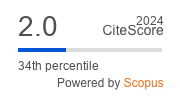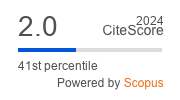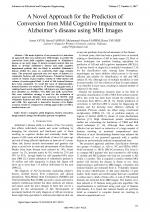| 2/2017 - 15 |
A Novel Approach for the Prediction of Conversion from Mild Cognitive Impairment to Alzheimer's disease using MRI ImagesAYUB, A. |
| Extra paper information in |
| Click to see author's profile in |
| Download PDF |
Author keywords
computer aided diagnosis, feature extraction, image analysis, image classification, pattern recognition
References keywords
alzheimer(34), disease(29), classification(20), brain(14), neuroimage(13), cognitive(13), structural(12), mild(12), impairment(12), pattern(11)
Blue keywords are present in both the references section and the paper title.
About this article
Date of Publication: 2017-05-31
Volume 17, Issue 2, Year 2017, On page(s): 113 - 122
ISSN: 1582-7445, e-ISSN: 1844-7600
Digital Object Identifier: 10.4316/AECE.2017.02015
Web of Science Accession Number: 000405378100015
SCOPUS ID: 85020067022
Abstract
The main objective of our research is to introduce an approach that uses noninvasive MRI images to predict the conversion from mild cognitive impairment to Alzheimer's disease at an early stage. It detects normal controls that are likely to develop Alzheimer's disease and mild cognitive impairment patients that are likely to establish Alzheimer's disease within two years or, contrarily, their stage remains same. The proposed approach uses two types of features i.e. volumetric features and textural features. Volumetric features consist of volume of grey matter, volume of white matter and volume of cerebrospinal fluid. A total of 364 textural features have been calculated. To avoid the curse of dimensionality, textural features are reduced to 15 features using gain ratio, a ranking based search algorithm. All features are tested against four classifiers i.e. AODEsr, VFI, RBF and LBR. Leave-One-Out cross validation strategy is used for the evaluation of proposed approach. Results show accuracy of 98.33% with volumetric features and 100% with textural features using VFI and LBR. Our approach is innovative because of its higher accuracy results as compared to existing approaches yet with a smaller feature set. |
| References | | | Cited By «-- Click to see who has cited this paper |
| [1] "2015 Alzheimer's disease facts and figures," Alzheimer's & Dementia, vol. 11, pp. 332-384, 2015. [CrossRef] [Web of Science Times Cited 527] [SCOPUS Times Cited 1500] [2] R. Brookmeyer, E. Johnson, K. Ziegler-Graham, and H. M. Arrighi, "Forecasting the global burden of Alzheimer's disease," Alzheimer's & dementia, vol. 3, pp. 186-191, 2007 [CrossRef] [Web of Science Times Cited 2486] [SCOPUS Times Cited 2804] [3] S. Farhan, M. A. Fahiem, and H. Tauseef, "An Ensemble-of-Classifiers Based Approach for Early Diagnosis of Alzheimer's Disease: Classification Using Structural Features of Brain Images," Computational and mathematical methods in medicine, vol. 2014, 2014 [4] A. B. Tufail, A. Abidi, A. M. Siddiqui, and M. S. Younis, "Automatic classification of initial categories of Alzheimer's disease from structural MRI phase images: a comparison of PSVM, KNN and ANN methods," Age, vol. 75, pp. 76.13-7.55, 2012 [5] R. Casanova, F.-C. Hsu, K. M. Sink, S. R. Rapp, J. D. Williamson, et al., "Alzheimer's disease risk assessment using large-scale machine learning methods," PloS one, vol. 8, p. e77949, 2013. [CrossRef] [Web of Science Times Cited 82] [SCOPUS Times Cited 93] [6] S. Klöppel, C. M. Stonnington, C. Chu, B. Draganski, R. I. Scahill, et al., "Automatic classification of MR scans in Alzheimer's disease," Brain, vol. 131, pp. 681-689, 2008. [CrossRef] [Web of Science Times Cited 871] [SCOPUS Times Cited 1011] [7] Y. Fan, S. M. Resnick, X. Wu, and C. Davatzikos, "Structural and functional biomarkers of prodromal Alzheimer's disease: a high-dimensional pattern classification study," Neuroimage, vol. 41, pp. 277-285, 2008. [CrossRef] [Web of Science Times Cited 236] [SCOPUS Times Cited 263] [8] C. Davatzikos, P. Bhatt, L. M. Shaw, K. N. Batmanghelich, and J. Q. Trojanowski, "Prediction of MCI to AD conversion, via MRI, CSF biomarkers, and pattern classification," Neurobiology of aging, vol. 32, pp. 2322. e19-2322. e27, 2011 [9] K. A. Johnson, N. C. Fox, R. A. Sperling, and W. E. Klunk, "Brain imaging in Alzheimer disease," Cold Spring Harbor perspectives in medicine, vol. 2, p. a006213, 2012. [CrossRef] [Web of Science Times Cited 447] [SCOPUS Times Cited 538] [10] K. Kantarci and C. R. Jack, "Neuroimaging in Alzheimer disease: an evidence-based review," Neuroimaging Clinics of North America, vol. 13, pp. 197-209, 2003. [CrossRef] [Web of Science Times Cited 146] [SCOPUS Times Cited 174] [11] D. Zhang, Y. Wang, L. Zhou, H. Yuan, D. Shen, et al., "Multimodal classification of Alzheimer's disease and mild cognitive impairment," Neuroimage, vol. 55, pp. 856-867, 2011. [CrossRef] [Web of Science Times Cited 970] [SCOPUS Times Cited 1135] [12] E. Moradi, A. Pepe, C. Gaser, H. Huttunen, J. Tohka, et al., "Machine learning framework for early MRI-based Alzheimer's conversion prediction in MCI subjects," NeuroImage, vol. 104, pp. 398-412, 2015. [CrossRef] [Web of Science Times Cited 494] [SCOPUS Times Cited 587] [13] G. Chetelat, B. Desgranges, V. De La Sayette, F. Viader, F. Eustache, et al., "Mapping gray matter loss with voxel-based morphometry in mild cognitive impairment," Neuroreport, vol. 13, pp. 1939-1943, 2002. [CrossRef] [SCOPUS Times Cited 326] [14] J. Ashburner and K. J. Friston, "Voxel-based morphometry-the methods," Neuroimage, vol. 11, pp. 805-821, 2000. [CrossRef] [Web of Science Times Cited 7054] [SCOPUS Times Cited 7491] [15] J. E. Arco, J. Ramírez, J. M. Gorriz, C. G. Puntonet, and M. Ruz, "Short-term Prediction of MCI to AD conversion based on Longitudinal MRI analysis and neuropsychological tests," in Innovation in Medicine and Healthcare 2015, ed: Springer, 2016, pp. 385-394. [CrossRef] [Web of Science Times Cited 11] [SCOPUS Times Cited 11] [16] C. Davatzikos, S. M. Resnick, X. Wu, P. Parmpi, and C. M. Clark, "Individual patient diagnosis of AD and FTD via high-dimensional pattern classification of MRI," Neuroimage, vol. 41, pp. 1220-1227, 2008. [CrossRef] [Web of Science Times Cited 193] [SCOPUS Times Cited 209] [17] R. C. Petersen, "Mild cognitive impairment as a diagnostic entity," Journal of internal medicine, vol. 256, pp. 183-194, 2004. [CrossRef] [Web of Science Times Cited 6001] [SCOPUS Times Cited 6470] [18] L. M. Shaw, H. Vanderstichele, M. Knapik-Czajka, C. M. Clark, P. S. Aisen, et al., "Cerebrospinal fluid biomarker signature in Alzheimer's disease neuroimaging initiative subjects," Annals of neurology, vol. 65, pp. 403-413, 2009. [CrossRef] [Web of Science Times Cited 1669] [SCOPUS Times Cited 1762] [19] R. M. Chapman, M. Mapstone, J. W. McCrary, M. N. Gardner, A. Porsteinsson, et al., "Predicting conversion from mild cognitive impairment to Alzheimer's disease using neuropsychological tests and multivariate methods," Journal of clinical and experimental neuropsychology, vol. 33, pp. 187-199, 2011. [CrossRef] [Web of Science Times Cited 83] [SCOPUS Times Cited 89] [20] C. R. Jack, V. J. Lowe, M. L. Senjem, S. D. Weigand, B. J. Kemp, et al., "11C PiB and structural MRI provide complementary information in imaging of Alzheimer's disease and amnestic mild cognitive impairment," Brain, vol. 131, pp. 665-680, 2008. [CrossRef] [Web of Science Times Cited 773] [SCOPUS Times Cited 833] [21] C. D. Good, R. I. Scahill, N. C. Fox, J. Ashburner, K. J. Friston, et al., "Automatic differentiation of anatomical patterns in the human brain: validation with studies of degenerative dementias," Neuroimage, vol. 17, pp. 29-46, 2002. [CrossRef] [Web of Science Times Cited 341] [SCOPUS Times Cited 365] [22] O. Colliot, G. Chetelat, M. Chupin, B. Desgranges, B. Magnin, et al., "Discrimination between Alzheimer Disease, Mild Cognitive Impairment, and Normal Aging by Using Automated Segmentation of the Hippocampus 1," Radiology, vol. 248, pp. 194-201, 2008. [CrossRef] [Web of Science Times Cited 214] [SCOPUS Times Cited 238] [23] C. Misra, Y. Fan, and C. Davatzikos, "Baseline and longitudinal patterns of brain atrophy in MCI patients, and their use in prediction of short-term conversion to AD: results from ADNI," Neuroimage, vol. 44, pp. 1415-1422, 2009. [CrossRef] [Web of Science Times Cited 442] [SCOPUS Times Cited 485] [24] A. Mechelli, C. J. Price, K. J. Friston, and J. Ashburner, "Voxel-based morphometry of the human brain: methods and applications," Current medical Imaging reviews, vol. 1, pp. 105-113, 2005. [CrossRef] [Web of Science Times Cited 693] [25] Y. Fan, N. Batmanghelich, C. M. Clark, C. Davatzikos, and A. s. D. N. Initiative, "Spatial patterns of brain atrophy in MCI patients, identified via high-dimensional pattern classification, predict subsequent cognitive decline," Neuroimage, vol. 39, pp. 1731-1743, 2008. [CrossRef] [Web of Science Times Cited 391] [SCOPUS Times Cited 437] [26] M. Bozzali, M. Filippi, G. Magnani, M. Cercignani, M. Franceschi, et al., "The contribution of voxel-based morphometry in staging patients with mild cognitive impairment," Neurology, vol. 67, pp. 453-460, 2006. [CrossRef] [Web of Science Times Cited 153] [SCOPUS Times Cited 170] [27] G. Chetelat, B. Landeau, F. Eustache, F. Mezenge, F. Viader, et al., "Using voxel-based morphometry to map the structural changes associated with rapid conversion in MCI: a longitudinal MRI study," Neuroimage, vol. 27, pp. 934-946, 2005. [CrossRef] [Web of Science Times Cited 426] [SCOPUS Times Cited 462] [28] Y. Hirata, H. Matsuda, K. Nemoto, T. Ohnishi, K. Hirao, et al., "Voxel-based morphometry to discriminate early Alzheimer's disease from controls," Neuroscience letters, vol. 382, pp. 269-274, 2005. [CrossRef] [Web of Science Times Cited 257] [SCOPUS Times Cited 289] [29] A. Hämäläinen, S. Tervo, M. Grau-Olivares, E. Niskanen, C. Pennanen, et al., "Voxel-based morphometry to detect brain atrophy in progressive mild cognitive impairment," Neuroimage, vol. 37, pp. 1122-1131, 2007. [CrossRef] [Web of Science Times Cited 121] [SCOPUS Times Cited 131] [30] C. Davatzikos, Y. Fan, X. Wu, D. Shen, and S. M. Resnick, "Detection of prodromal Alzheimer's disease via pattern classification of magnetic resonance imaging," Neurobiology of aging, vol. 29, pp. 514-523, 2008. [CrossRef] [Web of Science Times Cited 296] [SCOPUS Times Cited 349] [31] E. Gerardin, G. Chetelat, M. Chupin, R. Cuingnet, B. Desgranges, et al., "Multidimensional classification of hippocampal shape features discriminates Alzheimer's disease and mild cognitive impairment from normal aging," Neuroimage, vol. 47, pp. 1476-1486, 2009. [CrossRef] [Web of Science Times Cited 316] [SCOPUS Times Cited 364] [32] M. Chupin, E. Gerardin, R. Cuingnet, C. Boutet, L. Lemieux, et al., "Fully automatic hippocampus segmentation and classification in Alzheimer's disease and mild cognitive impairment applied on data from ADNI," Hippocampus, vol. 19, pp. 579-587, 2009. [CrossRef] [Web of Science Times Cited 247] [SCOPUS Times Cited 290] [33] S. L. Risacher, A. J. Saykin, J. D. Wes, L. Shen, H. A. Firpi, et al., "Baseline MRI predictors of conversion from MCI to probable AD in the ADNI cohort," Current Alzheimer Research, vol. 6, pp. 347-361, 2009. [CrossRef] [Web of Science Times Cited 398] [SCOPUS Times Cited 453] [34] Y. Fan, D. Shen, and C. Davatzikos, "Classification of structural images via high-dimensional image warping, robust feature extraction, and SVM," in Medical Image Computing and Computer-Assisted InterventionMICCAI 2005, ed: Springer, 2005, pp. 1-8. [CrossRef] [SCOPUS Times Cited 54] [35] A. Farzan, S. Mashohor, A. R. Ramli, and R. Mahmud, "Boosting diagnosis accuracy of Alzheimer's disease using high dimensional recognition of longitudinal brain atrophy patterns," Behavioural brain research, vol. 290, pp. 124-130, 2015. [CrossRef] [Web of Science Times Cited 40] [SCOPUS Times Cited 43] [36] L. Khedher, J. Ramírez, J. Gorriz, A. Brahim, F. Segovia, et al., "Early diagnosis of Alzheimer? s disease based on partial least squares, principal component analysis and support vector machine using segmented MRI images," Neurocomputing, vol. 151, pp. 139-150, 2015. [CrossRef] [Web of Science Times Cited 191] [SCOPUS Times Cited 234] [37] Y. Zhang, S. Wang, P. Phillips, Z. Dong, G. Ji, et al., "Detection of Alzheimer's disease and mild cognitive impairment based on structural volumetric MR images using 3D-DWT and WTA-KSVM trained by PSOTVAC," Biomedical Signal Processing and Control, vol. 21, pp. 58-73, 2015. [CrossRef] [Web of Science Times Cited 153] [SCOPUS Times Cited 165] [38] X. Long and C. Wyatt, "An automatic unsupervised classification of MR images in Alzheimer's disease," in Computer Vision and Pattern Recognition (CVPR), 2010 IEEE Conference on, 2010, pp. 2910-2917. [CrossRef] [Web of Science Times Cited 14] [SCOPUS Times Cited 21] [39] S. Farhan, M. A. Fahiem, F. Tahir, and H. Tauseef, "A Comparative Study of Neuroimaging and Pattern Recognition Techniques for Estimation of Alzheimer's," Life Science Journal, vol. 10, 2013. [40] A. Ortiz, J. M. Gorriz, J. Ramírez, F. J. Martínez-Murcia, and A. s. D. N. Initiative, "LVQ-SVM based CAD tool applied to structural MRI for the diagnosis of the Alzheimer's disease," Pattern Recognition Letters, vol. 34, pp. 1725-1733, 2013. [CrossRef] [Web of Science Times Cited 72] [SCOPUS Times Cited 87] [41] D. H. Ye, K. M. Pohl, and C. Davatzikos, "Semi-supervised pattern classification: application to structural MRI of Alzheimer's disease," in Pattern Recognition in NeuroImaging (PRNI), 2011 International Workshop on, 2011, pp. 1-4. [CrossRef] [SCOPUS Times Cited 43] [42] R. Filipovych, C. Davatzikos, and A. s. D. N. Initiative, "Semi-supervised pattern classification of medical images: application to mild cognitive impairment (MCI)," NeuroImage, vol. 55, pp. 1109-1119, 2011. [CrossRef] [Web of Science Times Cited 99] [SCOPUS Times Cited 122] [43] Y. Zhang, S. Wang, and Z. Dong, "Classification of Alzheimer disease based on structural magnetic resonance imaging by kernel support vector machine decision tree," Progress In Electromagnetics Research, vol. 144, pp. 171-184, 2014. [CrossRef] [Web of Science Times Cited 163] [SCOPUS Times Cited 191] [44] K. Hu, Y. Wang, K. Chen, L. Hou, and X. Zhang, "Multi-scale features extraction from baseline structure MRI for MCI patient classification and AD early diagnosis," Neurocomputing, vol. 175, pp. 132-145, 2016. [CrossRef] [Web of Science Times Cited 56] [SCOPUS Times Cited 67] [45] D. W. Shattuck and R. M. Leahy, "BrainSuite: an automated cortical surface identification tool," Medical image analysis, vol. 6, pp. 129-142, 2002. [CrossRef] [46] S. M. Smith and J. M. Brady, "SUSAN-a new approach to low level image processing," International journal of computer vision, vol. 23, pp. 45-78, 1997. [CrossRef] [Web of Science Times Cited 2188] [SCOPUS Times Cited 3004] [47] D. W. Shattuck, S. R. Sandor-Leahy, K. A. Schaper, D. A. Rottenberg, and R. M. Leahy, "Magnetic resonance image tissue classification using a partial volume model," NeuroImage, vol. 13, pp. 856-876, 2001. [CrossRef] [Web of Science Times Cited 764] [SCOPUS Times Cited 866] [48] M. Hall, E. Frank, G. Holmes, B. Pfahringer, P. Reutemann, et al., "The WEKA data mining software: an update," ACM SIGKDD explorations newsletter, vol. 11, pp. 10-18, 2009. [49] C. Ledig, R. Guerrero, T. Tong, K. Gray, A. Makropoulos, et al., "Alzheimer's disease state classification using structural volumetry, cortical thickness and intensity features," in Proc MICCAI workshop challenge on computer-aided diagnosis of dementia based on structural MRI data, 2014, pp. 55-64. [50] J. Zhang, C. Yu, G. Jiang, W. Liu, and L. Tong, "3D texture analysis on MRI images of Alzheimer's disease," Brain imaging and behavior, vol. 6, pp. 61-69, 2012. [CrossRef] [Web of Science Times Cited 104] [SCOPUS Times Cited 119] [51] P. Keserwani, V. C. Pammi, O. Prakash, A. Khare, and M. Jeon, "Classification of Alzheimer Disease using Gabor Texture Feature of Hippocampus Region," International Journal of Image, Graphics & Signal Processing, vol. 8, 2016. [52] J.-D. Lee, S.-C. Su, C.-H. Huang, W.-C. Xu, and Y.-Y. Wei, "Using volume features and shape features for Alzheimer's disease diagnosis," in Innovative Computing, Information and Control (ICICIC), 2009 Fourth International Conference on, 2009, pp. 437-440. [CrossRef] [SCOPUS Times Cited 6] Web of Science® Citations for all references: 30,182 TCR SCOPUS® Citations for all references: 34,351 TCR Web of Science® Average Citations per reference: 569 ACR SCOPUS® Average Citations per reference: 648 ACR TCR = Total Citations for References / ACR = Average Citations per Reference We introduced in 2010 - for the first time in scientific publishing, the term "References Weight", as a quantitative indication of the quality ... Read more Citations for references updated on 2025-05-31 21:46 in 299 seconds. Note1: Web of Science® is a registered trademark of Clarivate Analytics. Note2: SCOPUS® is a registered trademark of Elsevier B.V. Disclaimer: All queries to the respective databases were made by using the DOI record of every reference (where available). Due to technical problems beyond our control, the information is not always accurate. Please use the CrossRef link to visit the respective publisher site. |
Faculty of Electrical Engineering and Computer Science
Stefan cel Mare University of Suceava, Romania
All rights reserved: Advances in Electrical and Computer Engineering is a registered trademark of the Stefan cel Mare University of Suceava. No part of this publication may be reproduced, stored in a retrieval system, photocopied, recorded or archived, without the written permission from the Editor. When authors submit their papers for publication, they agree that the copyright for their article be transferred to the Faculty of Electrical Engineering and Computer Science, Stefan cel Mare University of Suceava, Romania, if and only if the articles are accepted for publication. The copyright covers the exclusive rights to reproduce and distribute the article, including reprints and translations.
Permission for other use: The copyright owner's consent does not extend to copying for general distribution, for promotion, for creating new works, or for resale. Specific written permission must be obtained from the Editor for such copying. Direct linking to files hosted on this website is strictly prohibited.
Disclaimer: Whilst every effort is made by the publishers and editorial board to see that no inaccurate or misleading data, opinions or statements appear in this journal, they wish to make it clear that all information and opinions formulated in the articles, as well as linguistic accuracy, are the sole responsibility of the author.



